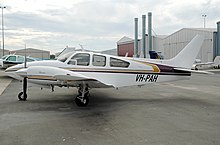Trans-World Airlines Flight 553
| Trans-World Airlines Flight 553 | |
|---|---|
|
A DC-9-15 of the TWA, similar to the accident machine |
|
| Accident summary | |
| Accident type | Air collision |
| place | near Urbana , Ohio |
| date | March 9, 1967 |
| Fatalities | 26th |
| Injured | 0 |
| 1. Aircraft | |
| Aircraft type | Douglas DC-9-15 |
| operator | Trans World Airlines |
| Mark | N1063T |
| Passengers | 21st |
| crew | 4th |
| Survivors | 0 |
| 2. Aircraft | |
| Aircraft type | Beechcraft Baron |
| operator | Tann Comp. |
| Mark | N6127V |
| Passengers | 0 |
| crew | 1 |
| Survivors | 0 |
| Lists of aviation accidents | |
Trans-World Airlines Flight 553 was the flight of a Douglas DC-9-15 with the air vehicle registration N1063T of Trans World Airlines . It flew on March 9, 1967 from Greater Pittsburgh Airport to Dayton Airport in Ohio . On the approach to Dayton, about 47 km from the airport, the aircraft collided with a Beechcraft Baron near Urbana . There were no survivors in the accident.
course
After the DC-9 passed Columbus in Ohio, the flight crew received clearance to descend from flight level 200 (approximately 20,000 feet (6100 m) above sea level) to 3000 feet (910 m). The Beechcraft flew in VMC conditions without contact with air traffic control . The DC-9 was in the control area of Dayton Radar Approach Control and its pilots were advised of uncontrolled visual air traffic ahead and slightly to the right about a mile away 18 seconds before the collision . The crew confirmed the tip. At an altitude of 4,500 feet (1,370 m) the DC-9 collided with the Beechcraft. At the time of the collision, the DC-9 was flying at a speed of 323 knots (about 600 km / h) in a south-westerly direction. The front right side of the DC-9 hit the left side of the Beechcraft and destroyed the twin-engine private aircraft, parts of which penetrated the front fuselage section of the DC-9 and damaged its flight controls . As a result, both planes crashed. All twenty-five occupants on board the DC-9 as well as the pilot of the Beechcraft were killed in the accident.
root cause
At the time of the accident, the conditions were visual flight conditions with thin clouds and visibility of six to seven miles (ten to eleven kilometers), more than twice the three miles required by the visual flight rules. According to visual flight rules, the pilots of the two aircraft had to see each other and avoid one another. In addition, the air traffic controller stated that he had not seen the Beechcraft on his radar until 22 seconds before the collision. Other air traffic controllers said that small planes near the scene of the accident were poorly detected by radar.
The American safety authority NTSB investigated the accident and found that, because of the high speed of the DC-9, both pilots did not see the other aircraft in time to prevent an accident.
Individual evidence
- ↑ accident report DC-9-15 N1063T , Aviation Safety Network (English), accessed on July 12, 2017th

